Physical Address
304 North Cardinal St.
Dorchester Center, MA 02124
The posterior and lateral anatomy of the knee joint presents a challenge to even the most experienced knee surgeon. Knowledge of the bony topography will result in a greater number of anatomic ligament reconstructions ( Fig. 2-1 ). A lack of familiarity leads to hesitancy when performing approaches in these areas of the knee. The inherent anatomic complexity of this region is further complicated by variations in terminology found in the orthopedic literature. Recent work by LaPrade and coworkers and others have attempted to clarify the nomenclature used to describe these structures, allowing for better communication among surgeons. These advances also facilitate more accurate biomechanic studies.
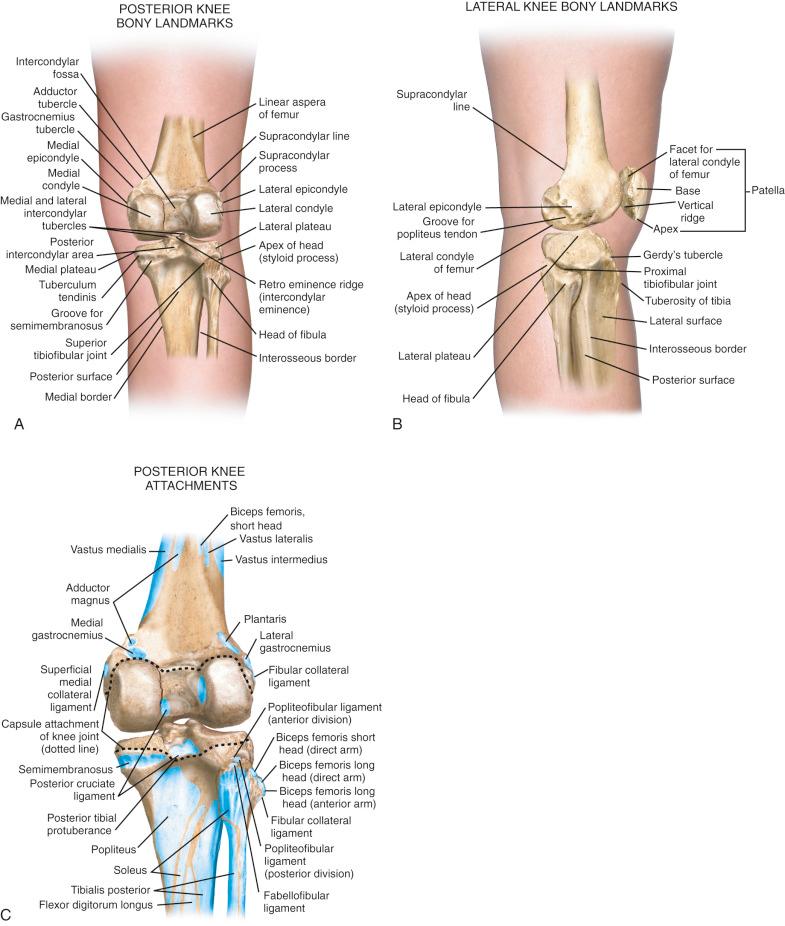
In posterolateral reconstructive procedures, the anatomic relationships of the fibular collateral ligament (FCL), popliteus muscle-tendon-ligament complex (PMTL), popliteofibular ligament (PFL), and the posterolateral capsule are particularly important. These structures function together to resist lateral joint opening, posterior subluxation of the lateral tibial plateau with tibial rotation, knee hyperextension, and varus recurvatum (see Chapter 15 ).
The goals of this chapter are to (1) accurately describe all relevant structures and their relationships to one another; (2) provide confidence to the knee surgeon when encountering the posterolateral aspect of the knee; and (3) apply knowledge of these structures to provide a base for safe and efficient surgical approaches to the posterolateral aspect of the knee.
The iliotibial band (ITB) is a large fascial expansion that originates on the anterior superior iliac spine, covering the tensor fascia lata muscle proximally and extending along the lateral aspect of the thigh. Distally, the ITB has been divided into three separate layers: superficial, deep, and the capsulo-osseous layer. A portion of the superficial layer, called the iliopatellar band , extends anteriorly to the lateral aspect of the patella ( Fig. 2-2 ). This band is important for proper patellofemoral tracking because it helps resist abnormal medial patella translation (medial glide). The majority of the superficial layer continues distally to insert on Gerdy's tubercle. The deep layer connects the medial portion of the superficial layer to the lateral intermuscular septum of the distal femur. The most distal fibers of the deep layer continue to attach to the posterior aspect of the lateral femoral condyle ( Fig. 2-3 ). The capsulo-osseous layer extends more medial and distal to the deep layer to merge with fibers from the short head of the biceps to form the biceps-capsulo-osseous iliotibial tract confluens. The capsulo-osseous layer continues distally, creating a sling posterior to the lateral femoral condyle to attach posterior and proximal to Gerdy's tubercle.
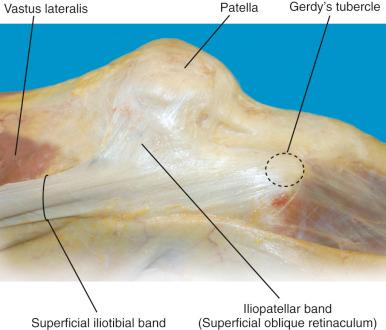
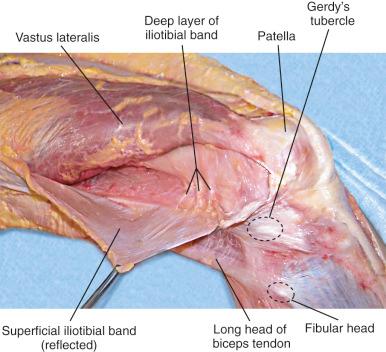
In knee extension, the ITB is anterior to the axis of rotation and helps maintain extension. When the knee is flexed to 90 degrees, the ITB moves posterior to the axis of rotation. The anteroposterior (AP) position of the ITB with knee flexion contributes to the pivot shift phenomena with an anterior cruciate ligament (ACL) rupture. The posterior portion of the ITB tibiofemoral attachment is re-created in the lateral extraarticular ACL reconstruction. During flexion, the ITB moves posteriorly, exerting an external rotational and posteriorly directed force on the lateral tibia, contributing to the reduction in the pivot shift test. The ITB and lateral capsule are important structures that resist internal tibial rotation (see Chapter 3 ). In extension, the ITB acts as a secondary restraint to varus stress. In severe lateral knee ligament injuries, the ITB may become abnormally lengthened, and at the time of surgery, distal advancement at Gerdy's tubercle is indicated. A bursa between the ITB and the lateral femoral epicondylar region may become inflamed and produce pain. The lateral retinacular nerve courses just posterior to the bursa and may also become symptomatic.
There has been recent interest in the lateral capsule and the so-called anterolateral ligament (ALL) that, when avulsed from the tibia, produces a Segond fracture. The contribution of the ALL in limiting internal tibial rotation and anterior translation of the lateral tibiofemoral compartment has not been defined. The ALL was first described in 1879 by the French surgeon Paul Segond as a fibrous band at the anterolateral aspect of the human knee attached to the Segond fracture. In 2012, Vincent and associates determined the incidence of this anatomic structure in 30 consecutive patients undergoing total knee arthroplasty. These authors also evaluated the ALL's anatomy and histology in 10 cadaver knees. They found that the ALL was present in all 40 knees.
Claes and associates performed an anatomic dissection on 41 unpaired cadaveric knees and reported the femoral and tibial attachments of the ALL, along with other lateral anatomic structures. These authors reported the ALL was a well-defined ligamentous structure in 40 of 41 knees. In another investigation, Claes and colleagues compared anatomic details of the ALL with radiographic findings from patients with known Segond fractures. These authors found that Segond fractures consistently avulsed where the ALL inserted on the proximal tibia. They suggested that the Segond fracture was not only an indirect sign of ACL injuries, but should be considered a ligamentous avulsion of the ALL.
Dodds and associates reported in an anatomic study that the ALL inserted just proximal and posterior to the lateral femoral epicondyle. The ALL has an oblique course to the anterolateral aspect of the proximal tibia, with attachments to the lateral meniscus, enveloping the inferior lateral geniculate artery and vein. It inserts onto the anterolateral tibia midway between Gerdy's tubercle and the tip of the fibular head, separate from the ITB.
In an anatomic dissection of 15 cadaver specimens (males, mean age, 58.2 years), Kennedy and colleagues reported that the ALL femoral attachment's area was 67.7 mm 2 , which was located a mean of 2.7 mm proximal and 2.8 mm posterior to the FCL's femoral attachment (range, 0.9–6.7 mm proximal and 0.2–7.7 mm posterior; Fig. 2-4 ). The ALL had fine fascial expansions that extended anterior and distal over the FCL and lateral epicondyle. The ALL attachment was an average of 7.0 mm from the lateral epicondyle and 26.1 mm from the joint line. The tibial attachment was approximately midway between the anterior margin of the fibular head and the center of Gerdy's tubercle ( Fig. 2-5 ). The ALL attachment was a mean of 26.1 mm anterior to the fibular head margin and 24.7 mm posterior to Gerdy's tubercle center, with a mean attachment area of 64.9 mm 2 . The respective lengths from 0 to 90 degrees ranged from a mean of 36.8 to 41.6 mm. The mean maximum load to failure was 175 N (confidence interval, 139–211 mm).
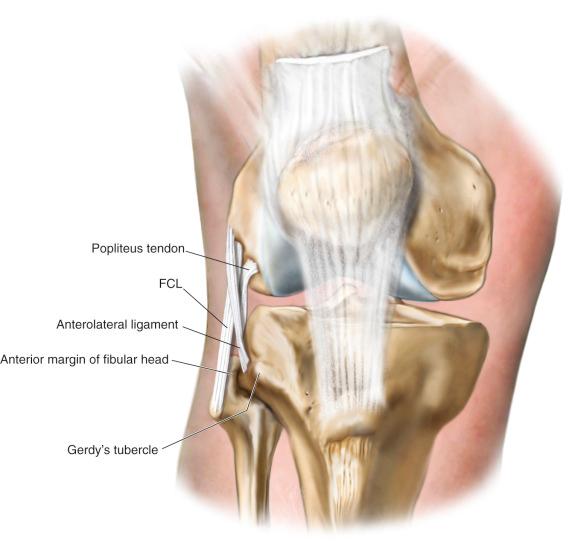
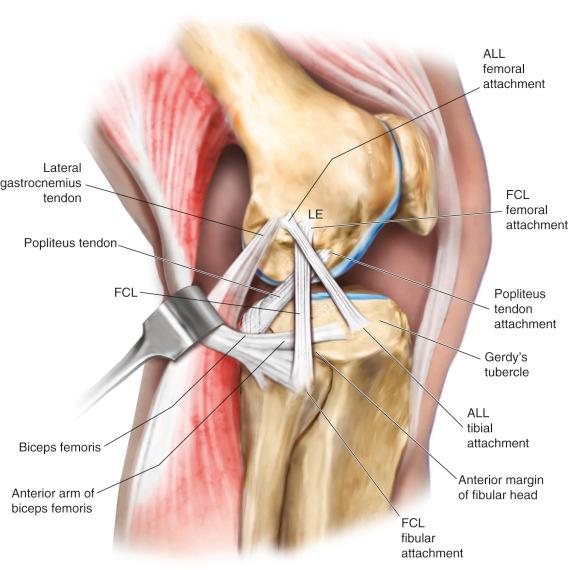
It has been hypothesized by some that the ALL, along with the ITB femoral-tibial insertion, is a secondary restraint to internal tibial rotation and anterior translation of the lateral tibial plateau. Wodicka and coworkers found no correlation between the degree of injury to the ALL and the degree of instability after an ACL rupture. They proposed that the ALL in itself plays a minimal role in stability of the knee. Unpublished robotic research in our laboratory has confirmed no statistically significant increases in internal tibial rotation or lateral compartment translation upon sectioning the ALL. Accordingly, these two structures represent secondary restraints to lateral tibiofemoral compartment translation after ACL disruption. In our experience with anatomic dissections, it has been rare to find such a well-defined, robust structure ( Fig. 2-6 ).
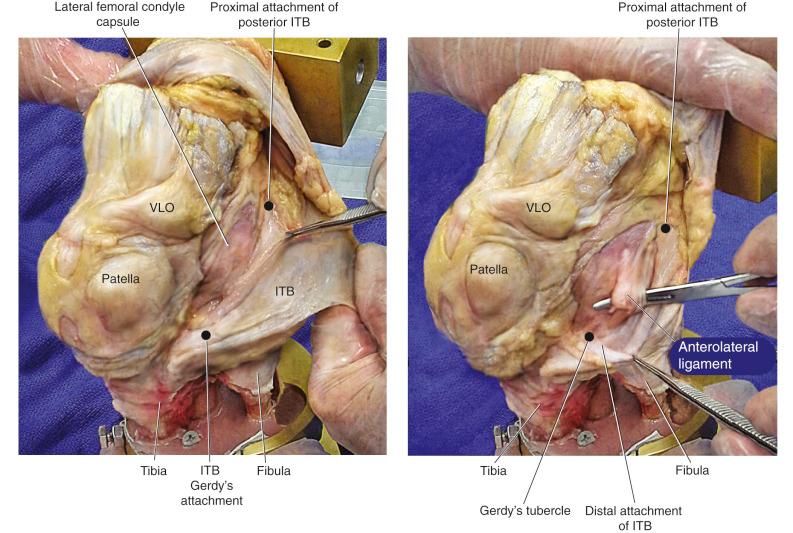
Become a Clinical Tree membership for Full access and enjoy Unlimited articles
If you are a member. Log in here